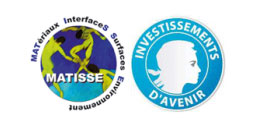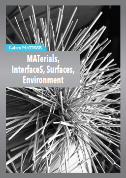Etude des propriétés photoniques de diatomées

Axe 2 - Matériaux multifonctionnels et environnement
Thèse de Ali Mcheik
Travail de recherche commencé le 1er octobre 2015.
Soutenance le 28 septembre 2018 à 14h30
Amphithéâtre HERPIN - bâtiment Esclangon
Campus Pierre et Marie Curie
Sorbonne Université - 4 place Jussieu 75005 Paris
Laboratoires co-porteurs
- Chimie de la Matière Condensée de Paris (LCMCP)
Porteuse de Projet : Sophie Cassaignon - Institut des NanoSciences de Paris (INSP)
Co-encadrant : Serge Berthier - Biologie des Organismes et Ecosystèmes Aquatiques (BOREA)
Co-encadrant : Pascal Lopez - Collège de France
Co-encadrant : Jacques Livage
Abstracts
The work presented in this thesis deals with the study of the photonic properties of four diatom species of the genus Coscinodiscus: C. wailesii, C. specie, C. radiatus et C. radiatuscf. Diatoms are unicellular microalgae consisting of a single cell encapsulated in an inorganic matrix of porous silica called frustule. We performed cultures of these species, then extracted the frustules to characterize them, both in terms of their composition and their morphology, by electron microscopy and X-ray tomography. The frustule consists of three silica layers (the foramen, cribrum and cribellum) with a hierarchical porous structure, ranging from micrometer to nanometer scale, and thus forming a complex three-dimensional matrix that may have photonic properties. The foramen and cribrum have periodic pores networks whose characteristic dimensions (pore size, lattice constant…) are of the order of light wavelengths. The optical properties of the frustules were then studied experimentally by spectral imaging and theoratically by numerical simulations by finite element method. We demonstrated a concentration effect of visible light transmitted on diatom’s axis a few tens of micrometers behind the frustule. This effect appears to depend on the incident wavelength as well as the orientation of the frustule. Finally, we have shown by theoratical approach and numerical simulations, that light concentration effect along the axis is mainly due to the foramen and the rest of layers have only a marginal effect. Such complex micro and nano-structuring of matter is currently impossible on an industrial scale. This structure, however, has optical effects of light concentration and filtration of great interest in many fields (photovoltaics, cosmetics, paint…) and it is therefore reasonnable to consider a direct use of diatoms.
Publication
- A. Mcheik, S. Cassaignon, J. Livage, A. Gibaud, S. Berthier, P.J. Lopez,
Optical Properties of Nanostructured Silica Structures From Marine Organisms,
Frontiers in Marine Science, volume 5, 2018
DOI : 10.3389/fmars.2018.00123 - A. Gibaud, J. Villanova, O. Cherkas, A. Bulou, L. Kamtcheu Ouanssi, A. Mcheik, S. Cassaignon, P.J. Lopez, S. Berthier
Analysis of diatoms by holotomography
Surfaces and Interfaces 17 (2019) 100358
DOI : 10.1016/j.surfin.2019.100358
Interventions et colloques
- Colloque Recherche Inspirées de la Biodiversité, Grande Galerie de l’Evolution MNHN, Paris, France.
- Living Light 2015, Scripps Institution of Oceanography, San-Diego, Etats-Unis.
- Colloque Scientifiques MNHN, Université de Caen, Caen, France.
- Journée Labex Matisse 2017, Sorbonne Université, Paris, France.
- Journée Labex Matisse 2018, Sorbonne Université, Paris, France.
Egalement dans la rubrique
MATISSE en chiffres
- 4 disciplines : Chimie, Physique, Sciences de la Terre, Patrimoine
- 400 permanents
Contact
Direction
Florence Babonneau
Administration
Communication
Emmanuel Sautjeau



